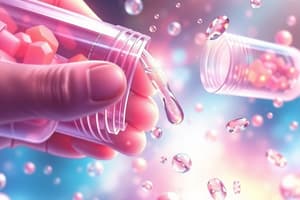Podcast
Questions and Answers
What does the symbol '%' represent in the context of pharmaceutical solutions?
What does the symbol '%' represent in the context of pharmaceutical solutions?
It represents percent weight in volume for solute in liquids, percent volume in volume for liquid mixtures, and weight in weight for solid mixtures.
Why do pharmacists typically avoid using heat when preparing solutions?
Why do pharmacists typically avoid using heat when preparing solutions?
Pharmacists avoid heat to prevent the destruction of medicinal agents and deterioration of drugs.
How can the rate of dissolution of certain solutes be improved without using heat?
How can the rate of dissolution of certain solutes be improved without using heat?
The rate of dissolution can be improved by reducing the particle size of the solute or by subjecting the mixture to vigorous agitation.
What risks are associated with dissolving volatile solutes or using volatile solvents?
What risks are associated with dissolving volatile solutes or using volatile solvents?
What role does particle size play in the preparation of pharmaceutical solutions?
What role does particle size play in the preparation of pharmaceutical solutions?
Describe how exothermic reactions involving calcium salts can affect the preparation of solutions.
Describe how exothermic reactions involving calcium salts can affect the preparation of solutions.
What is the general method used for preparing solutions on an industrial scale?
What is the general method used for preparing solutions on an industrial scale?
What defines the stability of pharmaceutical preparations over time?
What defines the stability of pharmaceutical preparations over time?
What is the primary purpose of stabilizers in oral solutions?
What is the primary purpose of stabilizers in oral solutions?
How does a drug's expiration date relate to its stability?
How does a drug's expiration date relate to its stability?
Why are flavorants and colorants used in oral medications?
Why are flavorants and colorants used in oral medications?
What is meant by the term 'shelf life' for oral solutions?
What is meant by the term 'shelf life' for oral solutions?
What component is often absent in dry mixtures for solution compared to ready-to-use oral solutions?
What component is often absent in dry mixtures for solution compared to ready-to-use oral solutions?
What factors might influence the palatability of oral solutions?
What factors might influence the palatability of oral solutions?
Why is it important for oral solutions to be effective in terms of absorption?
Why is it important for oral solutions to be effective in terms of absorption?
What role do preservatives play in oral solutions?
What role do preservatives play in oral solutions?
What potential issue must pharmacists consider when formulating oral solutions?
What potential issue must pharmacists consider when formulating oral solutions?
What is the significance of offering certain antibiotics as dry powder instead of in liquid form?
What is the significance of offering certain antibiotics as dry powder instead of in liquid form?
What is the typical storage duration for a reconstituted solution in the refrigerator?
What is the typical storage duration for a reconstituted solution in the refrigerator?
What should patients do with any remaining medication after completing their course of therapy?
What should patients do with any remaining medication after completing their course of therapy?
List one way a pharmacist can prepare an oral solution.
List one way a pharmacist can prepare an oral solution.
What are oral rehydration solutions (ORS) typically used to treat?
What are oral rehydration solutions (ORS) typically used to treat?
What electrolytes are commonly lost during diarrhea that can lead to severe health complications?
What electrolytes are commonly lost during diarrhea that can lead to severe health complications?
What is a potential consequence of continuous vomiting and diarrhea?
What is a potential consequence of continuous vomiting and diarrhea?
What is the importance of the specific quantities of electrolytes in a liter of oral rehydration solution?
What is the importance of the specific quantities of electrolytes in a liter of oral rehydration solution?
What is one advantage of oral rehydration salts solutions over parenterally administered electrolyte solutions?
What is one advantage of oral rehydration salts solutions over parenterally administered electrolyte solutions?
In what forms are oral rehydration solutions typically available?
In what forms are oral rehydration solutions typically available?
What should pharmacists advise patients regarding the mixing of oral solutions with other beverages?
What should pharmacists advise patients regarding the mixing of oral solutions with other beverages?
What is the primary component required in magnesium citrate solution to achieve 1.55 to 1.9 g of magnesium oxide per 100 mL?
What is the primary component required in magnesium citrate solution to achieve 1.55 to 1.9 g of magnesium oxide per 100 mL?
What role does carbonation play in the preparation of magnesium citrate solution?
What role does carbonation play in the preparation of magnesium citrate solution?
Why is systemic alkalinization important for patients with uric acid and cystine calculi?
Why is systemic alkalinization important for patients with uric acid and cystine calculi?
What distinguishes aromatic waters from medicinal solutions?
What distinguishes aromatic waters from medicinal solutions?
How are the strengths of diluted acids typically expressed?
How are the strengths of diluted acids typically expressed?
What are the main drawbacks of traditional bowel preparation methods for colonoscopy?
What are the main drawbacks of traditional bowel preparation methods for colonoscopy?
What is the primary component that acts as an osmotic agent in the oral colonic lavage solution?
What is the primary component that acts as an osmotic agent in the oral colonic lavage solution?
What is the total volume of oral colonic lavage solution recommended for adults before a procedure?
What is the total volume of oral colonic lavage solution recommended for adults before a procedure?
How quickly should patients consume each portion of the oral colonic lavage solution?
How quickly should patients consume each portion of the oral colonic lavage solution?
Why should oral colonic lavage solution not be mixed with other electrolyte-containing liquids?
Why should oral colonic lavage solution not be mixed with other electrolyte-containing liquids?
What ions are balanced in the formulation of the oral colonic lavage solution?
What ions are balanced in the formulation of the oral colonic lavage solution?
When can patients typically expect their first bowel movement after consuming the colonic lavage solution?
When can patients typically expect their first bowel movement after consuming the colonic lavage solution?
What additional preparations can be avoided by using the oral colonic lavage solution?
What additional preparations can be avoided by using the oral colonic lavage solution?
What is the taste profile of magnesium citrate oral solution?
What is the taste profile of magnesium citrate oral solution?
What schedule is recommended for patients consuming the oral colonic lavage solution before a midmorning procedure?
What schedule is recommended for patients consuming the oral colonic lavage solution before a midmorning procedure?
Flashcards are hidden until you start studying
Study Notes
Pharmaceutical Solutions
- Pharmaceutical solutions are typically unsaturated, meaning the amount of solute dissolved is less than the solvent's capacity.
- Strength is often expressed as percent strength:
- Percent weight in volume for solutions of solids or gases in liquids
- Percent volume in volume for solutions of liquids in liquids
- Weight in weight for mixtures of solids and semisolids
- Dissolving solutes may require:
- Heat (used cautiously to avoid drug degradation)
- Reducing particle size (comminution)
- Solubilizing agents
- Agitation
- Solutions are typically prepared by simple mixing, with larger-scale production utilizing mixing vessels with mechanical stirrers.
- Stability of a pharmaceutical preparation refers to its ability to maintain therapeutic activity and avoid undesirable changes over time.
- Drug expiration dates indicate the period during which a product remains stable when stored as directed.
Oral Solutions
- Oral solutions typically contain flavorants, colorants, stabilizers, and preservatives.
- Palatable solutions are essential for patient acceptance and compliance.
- Stability ensures the drug's integrity and efficacy.
- Effectiveness relates to the drug's absorption, distribution, and other properties.
- Liquid pharmaceuticals are often designed for small-volume doses (5 mL, 10 mL, or 15 mL).
Dry Mixtures for Solution
- Some medications, particularly antibiotics, are supplied as dry powder or granules for reconstitution with water before dispensing.
- Rec constituted solutions usually have a limited shelf life (7 to 14 days) when stored refrigerated.
Oral Rehydration Solutions
- Oral rehydration solutions (ORS) are used to treat dehydration caused by diarrhea, particularly in infants.
- They replenish lost fluids and electrolytes (sodium, potassium, bicarbonate).
- ORS are available over-the-counter and are effective for mild volume depletion.
- Typical ORS solutions contain:
- 45 mEq Na⁺
- 20 mEq K⁺
- 35 mEq Cl⁻
- 30 mEq citrate
- 25 g dextrose
Oral Colonic Lavage Solution
- An alternative to traditional bowel preparation for procedures like colonoscopies.
- A balanced electrolyte solution with polyethylene glycol (PEG-3350) is administered orally.
- PEG acts as an osmotic agent, drawing water into the gastrointestinal tract.
- The solution contains:
- 236.00 g PEG-3350
- 22.74 g Sodium sulfate
- 6.74 g Sodium bicarbonate
- 5.86 g Sodium chloride
- 2.97 g Potassium chloride
- The recommended adult dose is 4 L, consumed in 240 mL portions every 10 minutes.
Magnesium Citrate Oral Solution
- A colorless to slightly yellow, effervescent liquid with a sweet, acidic taste.
- Contains magnesium citrate equivalent to 1.55 to 1.9 g of magnesium oxide per 100 mL.
- Prepared by reacting magnesium carbonate with citric acid, followed by flavoring and carbonation.
- Used as a saline cathartic.
Sodium Citrate and Citric Acid Oral Solution
- Contains sodium citrate 100 mg and citric acid 67 mg per mL.
- Used as a systemic alkalinizer to maintain an alkaline urine in patients with urinary tract calculi or gout.
Miscellaneous Solutions
Aromatic Waters
- Clear, aqueous solutions saturated with volatile oils or aromatic substances.
- Provide pleasant flavoring for water-soluble drugs, emulsions, and suspensions.
- Not therapeutically potent due to low active ingredient concentration.
Diluted Acids
- Aqueous solutions prepared by diluting concentrated acids with purified water.
- Strength is expressed as percent weight-to-volume (% w/v).
- Limited use in modern medicine.
Studying That Suits You
Use AI to generate personalized quizzes and flashcards to suit your learning preferences.




